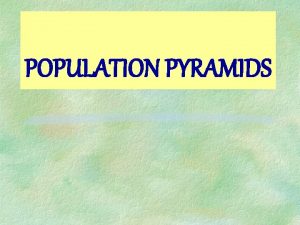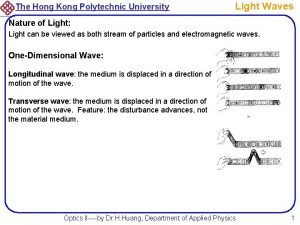The Hong Kong Polytechnic University Superposition of Light










- Slides: 10

The Hong Kong Polytechnic University Superposition of Light Waves Principle of Superposition: When two waves meet at a particular point in space, the resultant disturbance is simply the algebraic sum of the constituent disturbance. Addition of Waves of the Same Frequency: Let We have Resultant interference term Two waves in phase result in total constructive interference: Two waves anti-phase result in total destructive interference: Optics II----by Dr. H. Huang, Department of Applied Physics 1

The Hong Kong Polytechnic University Superposition of Light Waves Coherent: Initial phase difference 2 - 1 is constant. Incoherent: Initial phase difference 2 - 1 varies randomly with time. Phase difference for two waves at distance x 1 and x 2 from their sources, in a medium: Optical Path Difference (OPD): n(x 2 -x 1) Optical Thickness or Optical Path Length (OPL): nt Optics II----by Dr. H. Huang, Department of Applied Physics 2

The Hong Kong Polytechnic University Superposition of Light Waves Phasor Diagram: Each wave can be represented by a vector with a magnitude equal to the amplitude of the wave. The vector forms between the positive x-axis an angle equal to the phase angle . Suppose: For multiple waves: Optics II----by Dr. H. Huang, Department of Applied Physics 3

The Hong Kong Polytechnic University Superposition of Light Waves Example: Find the resultant of adding the sine waves: Example: Find, using algebraic addition, the amplitude and phase resulting from the addition of the two superposed waves and , where 1=0, 2= /2, E 1=8, E 2=6, and x=0. Optics II----by Dr. H. Huang, Department of Applied Physics 4

The Hong Kong Polytechnic University Superposition of Light Waves Example: Two waves and Calculate the resultant’s amplitude if E 1=3 and E 2=2. are coplanar and overlap. Example: Show that the optical path length, or more simply the optical path, is equivalent to the length of the path in vacuum which a beam of light of wavelength would traverse in the same time. Optics II----by Dr. H. Huang, Department of Applied Physics 5

The Hong Kong Polytechnic University Superposition of Light Waves Standing Wave; Suppose two waves: and having the same amplitude E 0 I=E 0 R and zero initial phase angles. Nodes at: nodes or nodal points antinodes Antinodes at: Optics II----by Dr. H. Huang, Department of Applied Physics 6

The Hong Kong Polytechnic University Superposition of Light Waves Addition of Waves of Different Frequency: Group velocity: dispersion relation = (k) Optics II----by Dr. H. Huang, Department of Applied Physics 7

The Hong Kong Polytechnic University Superposition of Light Waves Coherence: Frequency bandwidth: Coherent time: Coherent length: Example: (a) How many vacuum wavelengths of =500 nm will span space of 1 m in a vacuum? (b) How many wavelengths span the gap when the same gap has a 10 cm thick slab of glass (ng=1. 5) inserted in it? (c) Determine the optical path difference between the two cases. (d) Verify that OPD/ is the difference between the answers to (a) and (b). Optics II----by Dr. H. Huang, Department of Applied Physics 8

The Hong Kong Polytechnic University Superposition of Light Waves Example: In the figure, two waves 1 and 2 both have vacuum wavelengths of 500 nm. The waves arise from the same source and are in phase initially. Both waves travel an actual distance of 1 m but 2 passes through a glass tank with 1 cm thick walls and a 20 cm gap between the walls. The tank is filled with water (nw=1. 33) and the glass has refractive index ng=1. 5. Find the OPD and the phase difference when the waves have traveled the 1 m distance. Optics II----by Dr. H. Huang, Department of Applied Physics 9

The Hong Kong Polytechnic University Superposition of Light Waves Example: Show that the standing wave s(x, t) is periodic with time. That is, show that s(x, t)= s(x, t+ ). Homework: 11. 1; 11. 3; 11. 4; 11. 5; 11. 6 Optics II----by Dr. H. Huang, Department of Applied Physics 10


















